The New York Theatre Ballet performs at New York Live Arts, March 1 through 4.
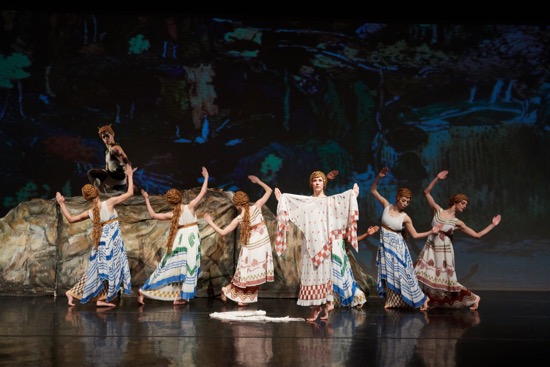
Vaslav Nijinsky’s L’Après-midi d’un faune. Elena Zahlmann (center) and Guyonn Auriau, Alexis Branagan, Carmella Lauer, Mayu Oguri, Amanda Treiber, and Jasmine Ward. At back: Steven Melendez. Photo Rachel Neville
Vaslav Nijinsky must have been charmed by ancient Greek vases when he choreographed his first ballet, L’Après-midi d’un faune, in 1912. Inspired by Stéphan Mallarmé’s poem of that name and Claude Debussy’s musical response to it (Prélude à l’après-midi d’un faune), he, however, depicted the nymphs and faun who peopled his imaginary glade in two dimensions, as if they lived their lives in horizontal bands encircling a flat surface. The version of this poetic little work that New York Theatre Ballet performed this week at New York Live Arts is the one revived by Ann Hutchinson Guest and Claudia Jeschke in 1987 (I regret that I haven’t read their book, Nijinsky’s Faune Restored). What these two expert scholars translated into Labanotation from a 1915 score containing Nijinsky’s own form of dance notation differs in many subtle ways from the ballet we’ve been used to seeing. That familiar version may be similar to the one Nijinsky strenuously decried when he saw a 1916 revival that had been pieced together from dancers’ memories and a few photographs.
The story that Nijinsky constructed—undoubtedly with advice from Sergei Diaghilev, the director of Les Balles Russes, the company for which it was made—is a simple one. A solitary faun lounges on a rock; a bevy of nymphs comes to the glade so that their leader can bathe in a pool below it. Left alone, she discards her outer garment, and the faun advances on her. Their single electric moment of contact is enough to arouse more than his curiosity, and when she flees, he spreads her discarded veil on his rock, lowers himself onto it, and arches back, open-mouthed, in what the shocked Parisian public understood as orgasmic release.
Hutchinson Guest came from England to coach New York Theatre Ballet in a production that had to be somewhat scaled down. Zheng Ma and Michael Scales play Maurice Ravel’s arrangement of the music for piano four hands. Leon Bakst’s magnificent backdrop exists in a projection of part of it. The Faun’s “rock” doesn’t blend in perfectly, but the reproductions of Bakst’s costumes and wigs are admirable, and the dancers have been scrupulous in capturing the two-dimensional style—their bodies twisted away from where their eyes are looking and their feet are moving. What differs from previous versions are mainly crucial details. This Faun (Joshua Andino-Nieto in the cast I saw) is not entirely self-preoccupied; he turns his head, as if hearing the nymphs coming; the Leading Nymph appears as fascinated by him as he by her.
Although the six attendant nymphs may form a single line or split into threes, one on either side of the stage, and although in their formality they evoke a vase painting, you sense traces of individuality. They seem less mechanical than heretofore, more involved. When the Leading Nymph (Elena Zahlmann) arrives to bathe in the invisible pool at her feet and carefully discards two of her veils, the companion retrieving them clutches them to herself before carrying them away.
Performing this fragrant little poem in a smallish non-proscenium house presents a slight difficulty in terms of spacing. Since the Faun can only move in horizontal tracks (cheating a bit to move into one further downstage), there’s an awkward moment when, curious, he comes very close to the nymphs, but they don’t see him yet. When, they do, of course, they raise their bent arms in terror and flee, leaving their leader alone with the Faun.
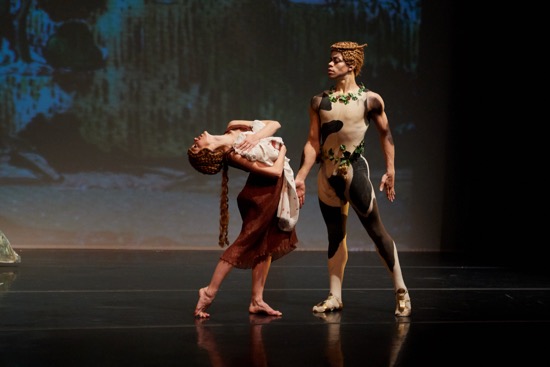
Elena Zahlmann and Steven Melendez in L’Après-midi d’un faune. Photo: Rachel Neville
Only one garment remains beside her rust-colored shift when the Faun, sensual even in his naiveté, aligns himself with her. Interestingly, they twice abandon their flattened positions to stand facing each other at close range, as if each were inhaling the scent of this other forest creature. Their most intimate contact comes when they link elbows, he looming above her, even though Nijinsky’s design keeps them as flat as if they were pressed between two pages. Various of her worried sister nymphs enter and retreat, afraid to pick up the veil, eager to shepherd her away. For the Faun, the veil is a surrogate—something redolent of her that he can brush against himself. The “shocking” ending is both succinct and delicate. The ballet was an excellent choice on the part of Diana Byer, the founder and artistic director of New York Theatre Ballet, and an impressive achievement by these dancers.
One clue to Byer’s interests lies in the company’s title. At some point “theater” became the accepted American spelling, but the French spelling still predominates in England, and Byer received much of her training in ballet from expatriate Brits Antony Tudor and Margaret Craske. Her dancers not only excel in works by Tudor, Frederick Ashton, and (from the next generation) Richard Alston, but also bring restraint and sensitivity to ballets by younger contemporary choreographers.
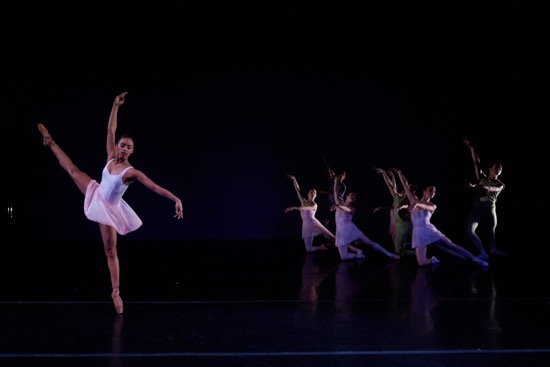
Amanda Smith (L) and cast members in Antonia Franceschi’s She Holds Out Her Hand. Photo: Rachel Neville
The company’s office, school, and studio space are located in Saint Mark’s Church. That’s where Antonia Franceschi’s She Holds Out Her Hand premiered last October and where I first saw Alston’s Such Longing a year and a half ago. The group’s recent season at New York Live Arts reinforces its identity as a “downtown” ballet company. In addition to L’Après-midi d’un faune, Franceschi’s work, and a pas de deux from Such Longing, the program offered the premiere of Light Moving by Pam Tanowitz (her third work to enter the repertory), and two solos: Ashton’s La Chatte metamorphosée en femme and Parts II and III of Steven Melendez’s new Tickling Titans.
She Holds Out Her Hand is set to a three-movement piano sonata written for it by Claire van Kampen and played by Scales, New York Theatre Ballet’s expert music director. The score takes its form from Japanese haiku (three lines of five syllables, seven syllables, and five syllables respectively), and the haiku printed in the program hints at what Franceschi’s ballet is about: “She holds out her hand/ On the path red blossom falls/ Snow finds the mountain.”
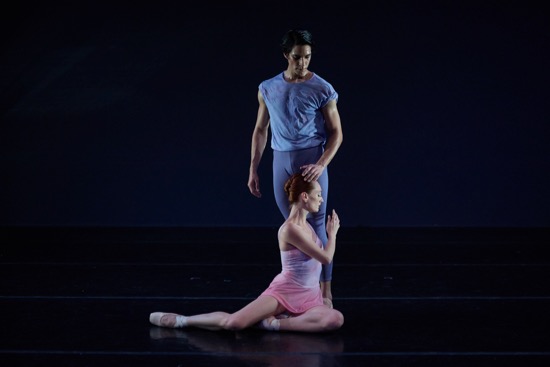
Amanda Treiber and Joshua Andino-Nieto in She Holds Out Her Hand. Photo: Rachel Neville
What you see is a group of five women (in pointe shoes) and three men, all wearing light-weight, pale colored costumes by Carmina de Dios. They might be celebrating the arrival of spring, although Alex Vásquez Dheming’s lighting design at times casts their shadows on the backdrop. They run in a big circle, they leap past. The movement breathes, suspends. Amanda Smith begins the piece alone, her dancing wonderfully full-bodied and clear. As She Holds Out Her Hand progresses, the group sometimes freezes, while a rivalry, or something vaguely like it, develops between Smith and Amanda Treiber. The latter, perhaps, is in need. A duet between her and Joshua Andino-Nieto involves traditional partnering, along with some awkward connections; its ending, with her sitting on the floor holding his leg as he stands calmly over her, is so strangely real and tender that I wished for more such moments. (I confess to cringing when a planted preparation for a turn breaks the spell of a dance whose flow is otherwise uninterrupted).
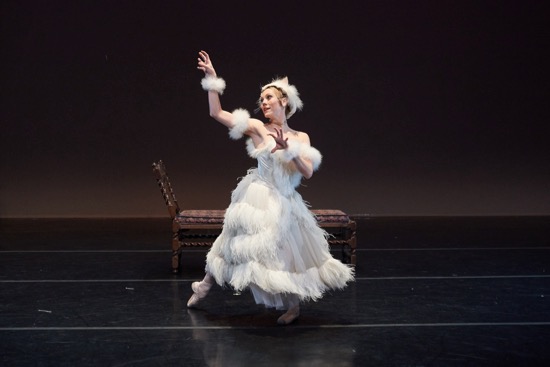
Elena Zahlmann in Frederick Ashton’s La Chatte Metamorphosée en femme. Photo: Rachel Neville
The two solos differ greatly. Ashton choreographed La Chatte metamorphosée en femme for the Royal Ballet’s Merle Park in 1985. The occasion was a gala in honor of the 19th-century ballerina Fanny Elsser, who had performed such a solo to great acclaim. The original choreography by Jean Coralli had, of course, disappeared, along with its music. Elena Zahlmann performs Ashton’s composition (staged by Byer to music drawn from an Offenbach operetta of that title) wearing the costume that William Chappell designed for Park. In that fluffy white gown, with whiskers that grow out of her headdress, Zahlmann charmingly depicts a self-satisfied creature with a tendency toward violence. She preens on her settee with feline poise; she also claws at it in order to ready herself for whatever small rodent might enter the vicinity. She struts around on pointe When she raises her hands, fingers spread and hooked, her eyes seem to get bigger and greedier. The clockwork mouse and the final “Meow!” are clever distractions from this embodiment of flirtatious cruelty.
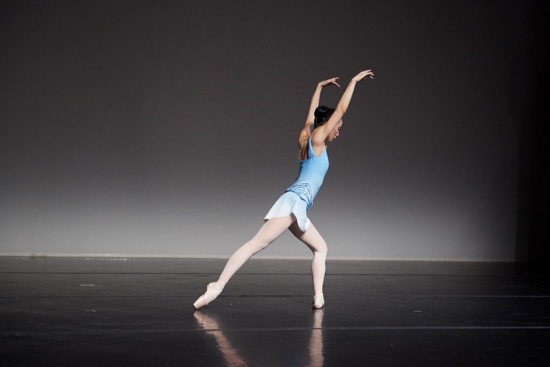
Mayu Oguri in Steven Melendez’s Tickling Titans (Parts II & III). Photo: Rachel Neville
Company member Melendez shows us another kind of woman in his Tickling Titans (Parts II and III). No ingratiating behavior from Mayu Oguri. She wears a blue leotard and skirt (by Carmella Lauer) and dances to Arnold Schoenberg’s Drei Klavierstücke, Op. 11, no. 2, excellently played by Scales. The music is labeled “Maßige,” and it has a massive sound—often with steady skirmishing in the bass notes, intermittent flights of melody above it, and sudden silences. The excellent Oguri is not exactly stern, but she’s very sober and concise. Often she holds her arms down by her sides (perhaps Melendez’s inheritance from Tudor), and this accentuates the simplicity and clarity of her movements. You can believe her wandering through the music, sometimes in narrow channels, as if it were a slightly troubling landscape that becomes faster and more tumultuous near the end. Vásquez Deming’s actual landscape—a very effective one—consists of her shadow, thrown onto the backdrop, multiplied by two or by four. Her own personal jungle.
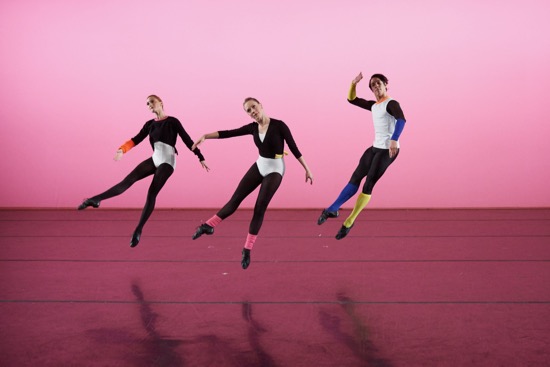
Pam Tanowitz’s Light Moving. (L to R): Amanda Treiber, Elena Zahlmann, and Joshua Andino-Nieto. Photo: Rachel Neville
Tanowitz’s trio Light Moving borrows its title from the piece by David Lang that accompanies it and is also played onstage by Scales and violinist Chloé Kiffer. Both music and dance are crisp and sprightly. Andino-Nieto, Treiber, and Zahlmann are costumed by Tristan Ramos in black shoes and trim black-and-white outfits with colors accenting an ankle here, a wrist there. They often move as a group and in unison, clear with their gestures and their positions. But they work together in other ways—grasping hands, say, and ducking under that grip; if Andino-Nieto lifts one of the women, the other may hold her friend’s hand. At one point, they separate and, for a brief, very welcome few moments, they all dance different material simultaneously.
I was struck all over again by the solo that opens the pas de deux from Such Longing (restaged by Martin Lawrance) and by how wonderfully Melendez performs Alston’s choreography. You sense him daydreaming; then there’ll be a sudden rush of movement, a twist, or a jagged little tap of one foot on the floor. He never loses that sense of thinking and perhaps responding to what he hears in the Chopin mazurka (Op. 17, no. 4) that Scales is playing so finely. Occasionally he pauses and draws himself up, bending very slightly to the side, with one curved arm held high, and you imagine that he might be thinking of embarking on an actual mazurka, or just finishing one.
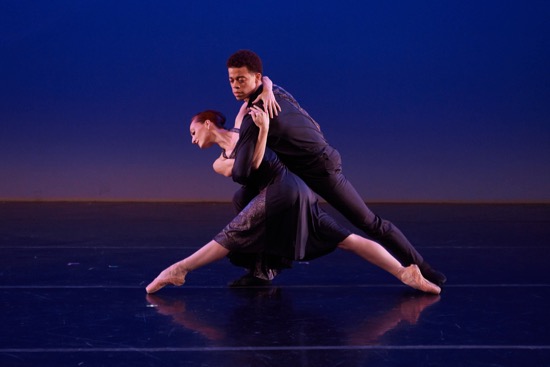
Amanda Treiber and Steven Melendez in Richard Alston’s Such Longing. Photo: Rachel Neville
He looks at the pianist when he’s done and is on his way out when Treiber arrives and he decides to stay. Now the music is a nocturne, Op. 27, no 2. Melendez embraces his partner in so many different fashions—bending her back over his knee, turning her into his arms—that you almost wonder how such intricate intimacies could be duplicated in real life affairs (dance tells it own stories in its own way, and we accept that). Melendez makes a “statement;” Treiber, we assume, approves. Perhaps because this duet is extracted from a longer work, it ends inconclusively, but it’s lovely while it lasts.
A small-scale evening as ballet performances go, but one rich in history and ideas and feelings and music.

Thanks Deborah for covering the whole program; it’s good to have some information about choreographers about whom I know little (and I don’t mean Ashton, or Alston by that!) The best Faune I’ve seen, and by Faune I mean the title character, was Portland contemporary dancer/choreographer Minh Tran, who performed it when he was in the graduate program in dance at the University of Washington many a year ago. He was close to feral in his affect and that was quite wonderful. My grandmother saw Nijinski in Paris, and henceforth referred to the ballet as Nijinski’s “scarf dance” with a little gasp, and a sparkle in her china blue eyes!
I too was most pleased by this program and was fortunate to see a rehearsal of Faune wiith Melendez and Andino-Nieto. Melendez, who I also saw in performance, is the more sensual as well as a more solid figure, while Andino-Nieto seemed younger, a difference to be seen in how each sniffed the nymph’s dropped scarf. Where Melendez seemed to be savoring the very physicality of her smell, for Andino-Nieto it was more of a perfume. Both were equally valid, of course.